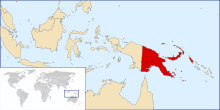

The following outline is provided as an overview of and topical guide to Papua New Guinea:
Papua New Guinea is a sovereign island nation of Oceania comprising the eastern half of the Island of New Guinea[a] and numerous offshore islands in the western South Pacific Ocean.[1] Papua New Guinea is located in a region defined since the early 19th century as Melanesia. Its capital, and one of its few major cities, is Port Moresby. It is one of the most diverse countries on Earth, with over 850 indigenous languages and at least as many traditional societies, out of a population of just under 6 million. It is also one of the most rural, with only 18 per cent of its people living in urban centres.[2] The country is also one of the world's least explored, culturally and geographically, and many undiscovered species of plants and animals are thought to exist in the interior of Papua New Guinea.
The majority of the population live in traditional societies and practise subsistence-based agriculture. These societies and clans have some explicit acknowledgement within the nation's constitutional framework. The PNG Constitution (Preamble 5(4)) expresses the wish for traditional villages and communities to remain as viable units of Papua New Guinean society,[3] and for active steps to be taken in their preservation. The PNG legislature has enacted various laws in which a type of tenure called "customary land title" is recognised, meaning that the traditional lands of the indigenous peoples have some legal basis to inalienable tenure. This customary land notionally covers most of the usable land in the country (some 97% of total land area);[4] alienated land is either held privately under State Lease or is government land. Freehold Title (also known as fee simple) can only be held by Papua New Guinea citizens.[5]
The country's geography is similarly diverse and, in places, extremely rugged. A spine of mountains runs the length of the island of New Guinea, forming a populous highlands region. Dense rainforests can be found in the lowland and coastal areas. This terrain has made it difficult for the country to develop transportation infrastructure. In some areas, planes are the only mode of transport. After being ruled by three external powers since 1884, Papua New Guinea gained its independence from Australia in 1975.
Cite error: There are <ref group=lower-alpha> tags or {{efn}} templates on this page, but the references will not show without a {{reflist|group=lower-alpha}} template or {{notelist}} template (see the help page).
- ^ "Papua New Guinea". The World Factbook. United States Central Intelligence Agency. 2 July 2009. Retrieved 23 July 2009.
- ^ "World Bank data on urbanisation". World Development Indicators. World Bank. 2005. Archived from the original on 3 February 2009. Retrieved 15 July 2005.
- ^ "Constitution of Independent State of Papua New Guinea (consol. to amendment #22)". Pacific Islands Legal Information Institute. Retrieved 16 July 2005.
- ^ Lynne Armitage. "Customary Land Tenure in Papua New Guinea: Status and Prospects" (PDF). Queensland University of Technology. Archived from the original (PDF) on 6 September 2005. Retrieved 15 July 2005.
- ^ HBW International Inc. (10 September 2003). "Facilitating Foreign Investment through Property Lease Options" (PDF). p. 9. Archived from the original (PDF) on 25 September 2007. Retrieved 28 August 2007. See footnote 30 which explains that the precise reference in legislation was not found.
